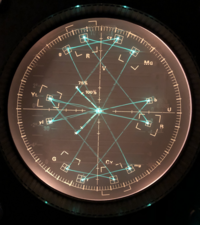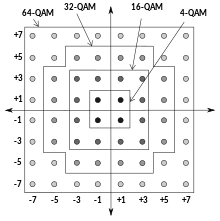Quadrature amplitude modulation
This articlemay be too technical for most readers to understand.(June 2020) |
| Passbandmodulation |
|---|
 |
| Analog modulation |
| Digital modulation |
| Hierarchical modulation |
| Spread spectrum |
| See also |
Quadrature amplitude modulation(QAM) is the name of a family ofdigital modulationmethods and a related family ofanalog modulationmethods widely used in moderntelecommunicationsto transmit information. It conveys two analog message signals, or two digitalbit streams,by changing (modulating) theamplitudesof twocarrier waves,using theamplitude-shift keying(ASK) digital modulation scheme oramplitude modulation(AM) analog modulation scheme. The two carrier waves are of the same frequency and areout of phasewith each other by 90°, a condition known asorthogonalityorquadrature.The transmitted signal is created by adding the two carrier waves together. At the receiver, the two waves can be coherently separated (demodulated) because of their orthogonality. Another key property is that the modulations are low-frequency/low-bandwidth waveforms compared to the carrier frequency, which is known as thenarrowband assumption.
Phase modulation(analog PM) andphase-shift keying(digital PSK) can be regarded as a special case of QAM, where the amplitude of the transmitted signal is a constant, but its phase varies. This can also be extended tofrequency modulation(FM) andfrequency-shift keying(FSK), for these can be regarded as a special case of phase modulation.
QAM is used extensively as a modulation scheme for digitaltelecommunicationsystems, such as in802.11Wi-Fi standards. Arbitrarily highspectral efficienciescan be achieved with QAM by setting a suitableconstellationsize, limited only by the noise level and linearity of the communications channel.[1]QAM is being used in optical fiber systems as bit rates increase; QAM16 and QAM64 can be optically emulated with a three-pathinterferometer.[2][3]
Demodulation[edit]

In a QAM signal, one carrier lags the other by 90°, and its amplitude modulation is customarily referred to as thein-phase component,denoted byI(t).The other modulating function is thequadrature component,Q(t).So the composite waveform is mathematically modeled as:
- or:
| (Eq.1) |
wherefcis the carrier frequency. At the receiver, acoherent demodulatormultiplies the received signal separately with both acosineandsinesignal to produce the received estimates ofI(t)andQ(t).For example:
Using standardtrigonometric identities,we can write this as:
Low-pass filteringr(t)removes the high frequency terms (containing4πfct), leaving only theI(t)term. This filtered signal is unaffected byQ(t),showing that the in-phase component can be received independently of the quadrature component. Similarly, we can multiplysc(t)by a sine wave and then low-pass filter to extractQ(t).

The addition of two sinusoids is a linear operation that creates no new frequency components. So the bandwidth of the composite signal is comparable to the bandwidth of the DSB (double-sideband) components. Effectively, the spectral redundancy of DSB enables a doubling of the information capacity using this technique. This comes at the expense of demodulation complexity. In particular, a DSB signal has zero-crossings at a regular frequency, which makes it easy to recover the phase of the carrier sinusoid. It is said to beself-clocking.But the sender and receiver of a quadrature-modulated signal must share a clock or otherwise send a clock signal. If the clock phases drift apart, the demodulatedIandQsignals bleed into each other, yieldingcrosstalk.In this context, the clock signal is called a "phase reference". Clock synchronization is typically achieved by transmitting a burstsubcarrieror apilot signal.The phase reference forNTSC,for example, is included within itscolorburstsignal.
Analog QAM is used in:
- NTSCandPALanalogcolor televisionsystems, where the I- and Q-signals carry the components of chroma (colour) information. The QAM carrier phase is recovered from a special colorburst transmitted at the beginning of each scan line.
- C-QUAM( "Compatible QAM" ) is used inAM stereoradio to carry the stereo difference information.
Fourier analysis[edit]
ApplyingEuler's formulato the sinusoids inEq.1,the positive-frequency portion ofsc(oranalytic representation) is:
wheredenotes the Fourier transform, andandare the transforms ofI(t)andQ(t).This result represents the sum of two DSB-SC signals with the same center frequency. The factor ofi(=eiπ/2)represents the 90° phase shift that enables their individual demodulations.
Digital QAM[edit]


As in many digital modulation schemes, theconstellation diagramis useful for QAM. In QAM, the constellation points are usually arranged in a square grid with equal vertical and horizontal spacing, although other configurations are possible (e.g. a hexagonal or triangular grid). In digitaltelecommunicationsthe data is usuallybinary,so the number of points in the grid is typically a power of 2 (2, 4, 8,…), corresponding to the number of bits per symbol. The simplest and most commonly used QAM constellations consist of points arranged in a square, i.e. 16-QAM, 64-QAM and 256-QAM (even powers of two). Non-square constellations, such as Cross-QAM, can offer greater efficiency but are rarely used because of the cost of increased modem complexity.
By moving to a higher-order constellation, it is possible to transmit morebitspersymbol.However, if the mean energy of the constellation is to remain the same (by way of making a fair comparison), the points must be closer together and are thus more susceptible tonoiseand other corruption; this results in a higherbit error rateand so higher-order QAM can deliver more data less reliably than lower-order QAM, for constant mean constellation energy. Using higher-order QAM without increasing the bit error rate requires a highersignal-to-noise ratio(SNR) by increasing signal energy, reducing noise, or both.
If data rates beyond those offered by 8-PSKare required, it is more usual to move to QAM since it achieves a greater distance between adjacent points in the I-Q plane by distributing the points more evenly. The complicating factor is that the points are no longer all the same amplitude and so thedemodulatormust now correctly detect bothphaseandamplitude,rather than just phase.
64-QAM and 256-QAM are often used indigital cabletelevision andcable modemapplications. In the United States, 64-QAM and 256-QAM are the mandated modulation schemes fordigital cable(seeQAM tuner) as standardised by theSCTEin the standardANSI/SCTE 07 2013.Note that many marketing people will refer to these as QAM-64 and QAM-256.[citation needed]In the UK, 64-QAM is used fordigital terrestrial television(Freeview) whilst 256-QAM is used for Freeview-HD.

Communication systems designed to achieve very high levels ofspectral efficiencyusually employ very dense QAM constellations. For example, current Homeplug AV2 500-Mbit/spowerline Ethernetdevices use 1024-QAM and 4096-QAM,[4]as well as future devices usingITU-TG.hnstandard for networking over existing home wiring (coaxial cable,phone linesandpower lines); 4096-QAM provides 12 bits/symbol. Another example isADSLtechnology for copper twisted pairs, whose constellation size goes up to 32768-QAM (in ADSL terminology this is referred to as bit-loading, or bit per tone, 32768-QAM being equivalent to 15 bits per tone).[5]
Ultra-high capacity microwave backhaul systems also use 1024-QAM.[6]With 1024-QAM,adaptive coding and modulation(ACM) andXPIC,vendors can obtain gigabit capacity in a single 56 MHz channel.[6]
Interference and noise[edit]
In moving to a higher order QAM constellation (higher data rate and mode) in hostileRF/microwaveQAM application environments, such as inbroadcastingortelecommunications,multipath interferencetypically increases. There is a spreading of the spots in the constellation, decreasing the separation between adjacent states, making it difficult for the receiver to decode the signal appropriately. In other words, there is reducednoiseimmunity. There are several test parameter measurements which help determine an optimal QAM mode for a specific operating environment. The following three are most significant:[7]
- Carrier/interference ratio
- Carrier-to-noise ratio
- Threshold-to-noise ratio
See also[edit]
- Amplitude and phase-shift keyingorasymmetric phase-shift keying(APSK)
- Carrierless amplitude phase modulation(CAP)
- Circle packing § Applications
- In-phase and quadrature components
- Modulationfor other examples of modulation techniques
- Phase-shift keying
- QAM tunerfor HDTV
- Random modulation
References[edit]
- ^"Digital Modulation Efficiencies".Barnard Microsystems. Archived fromthe originalon 2011-04-30.
- ^"Ciena tests 200G via 16-QAM with Japan-U.S. Cable Network".lightwave. April 17, 2014.Retrieved7 November2016.
- ^Kylia productsArchivedJuly 13, 2011, at theWayback Machine,dwdm mux demux, 90 degree optical hybrid, d(q) psk demodulatorssingle polarization
- ^http:// homeplug.org/media/filer_public/a1/46/a1464318-f5df-46c5-89dc-7243d8ccfcee/homeplug_av2_whitepaper_150907.pdfHomeplug_AV2 whitepaper
- ^http:// itu.int/rec/T-REC-G.992.3-200904-Isection 8.6.3 Constellation mapper - maximum number of bits per constellation BIMAX ≤ 15
- ^abhttp:// trangosys /products/point-to-point-wireless-backhaul/licensed-wireless/trangolink-apex-orion.shtmlA Apex Orion
- ^Howard Friedenberg and Sunil Naik."Hitless Space Diversity STL Enables IP+Audio in Narrow STL Bands"(PDF).2005 National Association of Broadcasters Annual Convention.Archived fromthe original(PDF)on March 23, 2006.RetrievedApril 17,2005.
Further reading[edit]
- Jonqyin (Russell) Sun "Linear diversity analysis for QAM in Rician fading channels", IEEE WOCC 2014
- John G. Proakis,"Digital Communications, 3rd Edition"
External links[edit]
- QAM Demodulation
- Interactive webdemo of QAM constellation with additive noiseInstitute of Telecommunicatons, University of Stuttgart
- QAM bit error rate for AWGN channel – online experiment
- How imperfections affect QAM constellation
- Microwave Phase ShiftersOverview byHerley General Microwave
- Simulation of dual-polarization QPSK (DP-QPSK) for 100G optical transmission




![{\displaystyle {\begin{aligned}r(t)&={\tfrac {1}{2}}I(t)\left[1+\cos(4\pi f_{c}t)\right]-{\tfrac {1}{2}}Q(t)\sin(4\pi f_{c}t)\\&={\tfrac {1}{2}}I(t)+{\tfrac {1}{2}}\left[I(t)\cos(4\pi f_{c}t)-Q(t)\sin(4\pi f_{c}t)\right].\end{aligned}}}](https://wikimedia.org/api/rest_v1/media/math/render/svg/548bd6eab15dcc86dd4f607025ffee024ce0c2c8)
![{\displaystyle s_{c}(t)_{+}={\tfrac {1}{2}}e^{i2\pi f_{c}t}[I(t)+iQ(t)]\quad {\stackrel {\mathcal {F}}{\Longrightarrow }}\quad {\tfrac {1}{2}}\left[{\widehat {I\ }}(f-f_{c})+e^{i\pi /2}{\widehat {Q}}(f-f_{c})\right],}](https://wikimedia.org/api/rest_v1/media/math/render/svg/627a100c3a2b79e4267617288854c5123cb52494)
